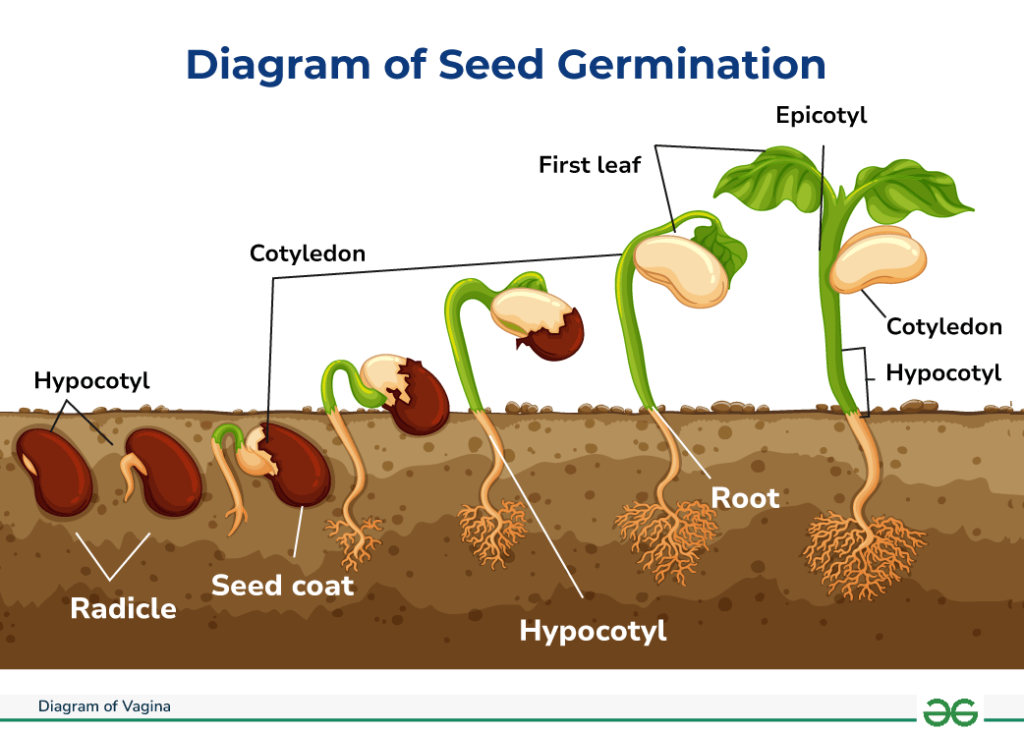
Germination of a seed is the process by which a seed develops into a new plant. It begins when a seed absorbs water and starts to grow. Germination requires specific environmental conditions like water, temperature, and oxygen. Here’s a detailed explanation of the steps involved in seed germination:
Steps in Seed Germination:
- Water Absorption (Imbibition):
- When a seed is placed in a moist environment, it begins to absorb water. This process is called imbibition. The water softens the seed coat and activates enzymes that are necessary for the growth process.
- Activation of Enzymes:
- As water is absorbed, it activates enzymes inside the seed. These enzymes break down stored food (usually starch) in the seed into simpler sugars, providing energy for the growing embryo.
- Swelling and Cracking of Seed Coat:
- The seed absorbs more water and starts to swell. This pressure causes the seed coat to crack open, allowing the emerging root and shoot to begin growing out.
- Radicle Emergence (Root Development):
- The radicle, or the embryonic root, is the first part of the seed to emerge. It grows downward to anchor the plant and start absorbing water and nutrients from the soil. This marks the start of the seed’s root system.
- Shoot Emergence (Stem and Leaves):
- After the root begins to grow, the hypocotyl (part of the seedling stem) pushes upward, carrying the shoot (stem) and leaves toward the surface. The shoot is the part that will eventually develop into the above-ground part of the plant.
- Photosynthesis Begins:
- Once the shoot breaks through the soil and exposes the leaves to sunlight, the plant can begin the process of photosynthesis. The leaves use sunlight, carbon dioxide, and water to produce food (glucose) for the plant.
- Development of the Seedling:
- Over time, the seedling grows, and more leaves, stems, and roots develop. The plant becomes independent of the stored food in the seed and starts to rely on photosynthesis and nutrient absorption from the soil.
Conditions Required for Germination:
For successful germination, the seed needs three main conditions:
- Water: Water is essential for the seed to absorb and activate enzymes that break down stored food for energy.
- Oxygen: Seeds need oxygen for cellular respiration, which provides the energy required for growth.
- Temperature: The right temperature (usually between 15°C to 25°C, depending on the plant species) is necessary for enzyme activity and the overall growth process.
- Light: Some seeds require light to germinate, while others prefer darkness. However, light becomes essential once the shoot has emerged for photosynthesis.
Phases of Germination:
- Imbibition: Water absorption and seed swelling.
- Activation: Enzymes start breaking down stored food.
- Growth: Radicle (root) and shoot emerge.
- Photosynthesis: The plant begins producing its own food.
- Seedling Formation: Full development of the plant as it grows.
In summary, germination is the crucial first step in the life cycle of a plant. It involves the seed’s transformation into a seedling, which will eventually mature into a fully-grown plant capable of reproduction.

Leave a Reply